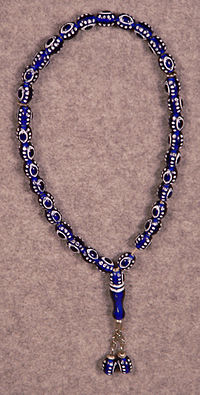Misbaha
As Misbaha ( Arabic مسبحة, DMG misbaḥa , also Masbaha ; Pl. مسابح / masābiḥ ) or Subha (سبحة, DMG subḥa ; Pl.سبح / subaḥ ) is a prayer chain commonly used in Islam . In non-Arabic languages or countries it is also called Tasbih , Tesbih or Tespih , which in Arabic actually describes the process of praise.
The prayer chain supports the speaking or counting of prayer formulas ( Tasbih /تسبيح / tasbīḥ / 'praise'; Pl. Tasabih /تسابيح / tasābīḥ ). It is also used as a talisman (good luck charm), hung up as a religious symbol or worn as a necklace.
history
In the early days of Islam, believers are said to have recited the name of God with the help of small stones or with their fingers instead of a tasbih . Because the Prophet Mohammed probably did not use a Misbaha , Wahhabis or other Orthodox scholars and Muslims, among others, reject it as a un-Islamic innovation (see Bidʿa ), although Muhammad's friend and first caliph Abu Bakr already used a kind of Misbaha in the form of a rope with knots .
The Misbaha and the rosary , derived from the Orthodox Komboskini , with which Catholic Christians pray in their prayer, originally come from India. In Hinduism and Buddhism, a mala is used as a prayer chain.
function
The Misbaha is an aid in the practice of the Dhikr , especially in Sufism , and it is used to make counting easier when the 99 names of Allah are spoken or Allah is extolled - often as a conclusion to prayer - with three formulas often used in Islam . The Muslim speaks 33 times Subhan-Allah (subḥānahu wa ta'ālā), "praised be God", 33 times al-hamdulillah (al-ḥamdu li-llāh), "praised be God" or "thank God", 33 times Allahu Akbar (allāhu akbar), "God is greater" and once the creed (Lā ilāha illā llāh), "There is no God but (the one) God". If Muslims do not carry or find a prayer beads with them, they count the formulas on their fingers.
Like the Greek komboloi , the misbaha is used today as jewelry by men and women, and wearing the misbaha is considered an attribute of masculinity.
shape
A Misbaha usually has 99 pearls, which are flexibly strung on a string and divided into three sections of 33 pearls each. In the past, the pearls were mostly made of wood, today mainly from semi-precious stones or plastic. Valuable Misbaha pearls have, among other things, elaborate incrustations (decorative metal inlays). Other materials are e.g. B. ivory , olive stones, glass or real pearls ; are particularly valuable z. B. Masabih made of blue amber .
The sections are each marked by an elongated or enlarged pearl of a different color; only one specially designed final pearl is sufficient. Shortly before the final pearl, Masabih often have a small side chain with up to ten pearls on a thick string. These pearls do not slip by themselves, they are used to record the number of prayer rounds. After each pass, a pearl is moved, which then stays in place. The main and side chains can be decorated at the ends with fabric tassels or pieces of jewelry.
There are also smaller masabih with 33 pearls, which are also widespread and are often carried along. A smaller number of pearls is also possible if, for example, some are lost and not replaced.
literature
- Helga Venzlaff: The Islamic Rosary (= treatises for the customer of the Orient. Vol. 47, 2). Steiner-Wiesbaden-GmbH, Stuttgart 1985, ISBN 3-515-04111-7 .
Web links
- Daniel da Cruz: Worry Beads. In: Saudi Aramco World, November / December 1968
- Damla Tönük: The Practice of Counting Prayers: Use of Tespih and Zikirmatik in Everyday Life in Turkey. (Master's thesis) Middle East Technical University, December 2011
Individual evidence
- ↑ Alec Corday, Hermann Dittrich: Amber - The Caribbean Approach. ( Memento of the original from September 3, 2011 in the Internet Archive ) Info: The archive link was inserted automatically and has not yet been checked. Please check the original and archive link according to the instructions and then remove this notice. In: Color , Autumn / Winter 2009, p. 2

